GIRL WITH A PEARL EARRING
Released: 2003
Directed by: Peter Webber
Written by: Olivia Hetreed (screenplay);
Tracy Chevalier (novel)
Cast:
Colin Firth: Johannes Vermeer
Scarlett Johansson: Griet
Tom Wilkinson: Van Ruijven
Essie Davis: Catharina Vermeer
|
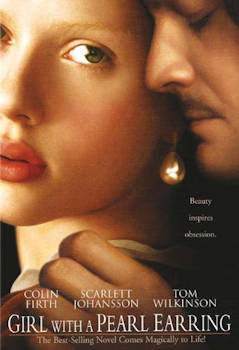
|
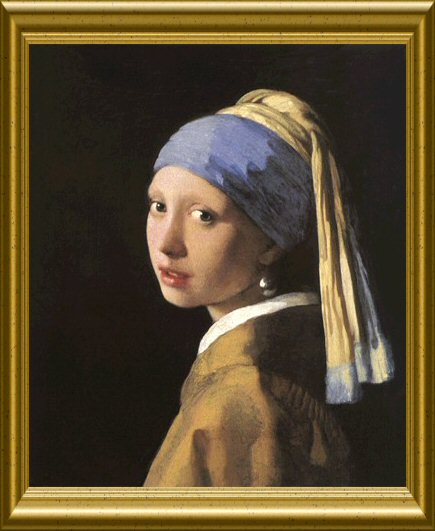
Girl With A Pearl Earring. Jan Vermeer, 1665
Review by Zimmerman Skyrat, 101Bananas.com, Dec. 2004
Girl With A Pearl Earring is based on a novel which purports to tell the story behind the painting of the same name, 17th century Dutch artist Jan Vermeer’s most famous painting, a painting that has been referred to as “the Mona Lisa of the North.” If you are at all seriously interested in art and the artistic process behind the creation of these cultural objects social man has come to call “art,” you will love this movie. My favorite kind of un-Hollywood movie: no murders, no gun battles, no car chases, no explosions. More is said and felt in a momentary glance between the two protagonists, a downcast pair of eyes, a brief brush against a sleeve in passing, than in the most explicit love scene Hollywood would dare film. A subtle, understated gem, much like Vermeer’s own paintings; perfectly photographed on a set that must have accurately reflected 17th century Holland. There is an excellent short “Making Of” featurette on the DVD, and since there’s no surprise ending to be revealed, I think I’d recommend that the short documentary be watched first for a better understanding of the story being told.
[If you like Girl With A Pearl Earring: I’m reminded of the French film La Belle Noiseuse, directed by Jacques Rivette and starring Emmanuelle Béart, Michel Piccoli and Jane Birkin. A 3-hour long exposition in great detail of the technical process behind the inspiration and the actual work that goes into a finished painting. Plus, you get to see Emmanuelle Béart totally nude for a large part of the 3 hours, which would be reason enough see the movie.]
Colin Firth is Jan Vermeer and Scarlett Johansson is Griet, a peasant girl hired as a maid to his family. Firth and Johansson are perfect for their parts, and it’s amazing how much Johansson, without makeup and very plain-looking, resembles the actual girl in the famous Vermeer painting. Unfortunately, this being 17th century Holland, we don’t get to see Johansson’s considerable charms, displayed to great effect in that memorable first half-minute of Sofia Coppola’s nice but otherwise unexciting movie, Lost In Translation.
The division and separation of social classes in Europe at the time portrayed in the movie is so strict and severe as to almost cause a scandal when it becomes known Vermeer is using a peasant maid as the subject for a painting—the usual subject would be a wealthy patron and/or his family. And, she’s wearing his wife’s earrings, no less. Oh! The shame and degradation! The scandal! But the artist knows best; through a series of small encounters, Vermeer has realized that Griet, despite a total lack of any formal education or training, has a natural talent for seeing the artistic possibilities in the intricate play of light and shadow on surfaces. He recognizes a kindred spirit, and at the insistance of a rich patron who is, shall we say, strongly attracted to Griet, uses her for the subject of his next painting. The rest, as they say, is history.
* * * * * *
What is it about a woman looking back over her shoulder at the artist, or today, at the camera? Why is it so common in paintings and photographs? I couldn’t say for sure, but partly there is the obvious simplistic voyeurism inherent in all art, you the viewer watching or catching someone momentarily by surprise, oblivious to the world, not knowing they’re being watched, the surprised look, the instantaneous second of unexplainable embarrassment. You have opened a door into a private room, and glimpsed something unguarded and unmasked. No wonder at one time or another everyone’s heard the demand: “Get that camera outta my face!”
This door you might not open, and you did;
So enter now, and see for what slight thing
You are betrayed...Here is no treasure hid,
No cauldron, no clear crystal mirroring
The sought-for Truth, no heads of women slain
For greed like yours, no writhings of distress;
But only what you see...Look yet again;
An empty room, cobwebbed and comfortless.
Yet this alone out of my life I kept
Unto myself, lest any know me quite;
And you did so profane me when you crept
Unto the threshold of this room tonight
That I must never more behold your face.
This now is yours. I seek another place.
—Edna St. Vincent Millay
I cannot remember the name of the photographer, but I remember what he said was his favorite photograph of Jackie Kennedy. It was black and white, not in perfect focus and in fact slightly blurred, the wind blowing a few strands of Jackie’s hair in her eyes. I believe they were on a beach somewhere; Jackie turned to look at him, smiling over her shoulder, and he snapped the picture.
Lookin’ through some photographs I found inside a drawer
I was taken by a photograph of you
There were one or two I know that you would have liked a little more
But they didn’t show your spirit quite as true
You were turning ’round to see who was behind you
And I took your childish laughter by surprise
And at the moment that my camera happened to find you
There was just a trace of sorrow in your eyes
—Jackson Browne
Strangely enough it holds true for animals too. I have a poster print by Jan Huston entitled “Alexander,” just a simple painting in photo-realistic style of a tabby cat looking back over his shoulder at you. It’s been many years since I bought the poster, but I remember that having owned (been owned by?) many cats in my life, the picture immediately struck me as capturing the essence of catness, whatever that is. I had seen that picture in real life many times before I ever saw the poster.
* * * * * *
The story behind famous paintings is often interesting in its own right, whether it’s da Vinci’s Mona Lisa, Van Gogh’s Starry Night, or Warhol’s Campbell’s soup cans. If the story told in Girl With A Pearl Earring interests you, you might also be interested in the book Strapless: John Singer Sargent and the Fall of Madame X, by Deborah Davis. This is the fascinating true story (not a novel) behind John Singer Sargent’s most famous and widely reproduced painting, known today as “Madame X,” which hangs in New York’s Metropolitan Museum of Art. First displayed to the public at the 1884 Paris Salon, it caused a scandalous sensation that we would laugh at today, simply because one strap of the model’s black evening gown was hanging down suggestively (or so people of the day thought) off her shoulder. Sargent, stunned and taken by surprise at the uproar, felt compelled to repaint that small detail of the portrait, replacing the strap on her shoulder, where it sits demurely today.
More about Sargent and the Madame X painting can be found online at the John Singer Sargent Virtual Gallery.
Deborah Davis' book Strapless is available at Amazon.com.
Girl With a Pearl Earring, Jan Vermeer (c1665)
The Guardian (U.K.) Online, Saturday, November 2, 2002
by Jonathan Jones
Artist: Jan Vermeer (1632-1675) left no more than 36 paintings—and the attribution of a couple of those is in doubt—and no drawings. This appears to be an accurate reflection of the number of works he produced. It may have been the rareness of his paintings that caused his name—well enough known in his native Dutch city of Delft in his lifetime—to become obscure after his death. Vermeer was not a totally unsuccessful artist. He became a head of the Guild of St Luke in Delft and his paintings fetched high prices, but he died in debt, and his Catholic wife Catharina Bolnes had to declare herself bankrupt. Vermeer, our Vermeer, is a modern artist, his cult dating from 1866 with the publication of a series of essays about him by the French art critic Théophile Thoré, a political radical and prophet of realism. Thoré saw the Renaissance tradition as an aristocratic plaything. He argued that art should represent the humble, and promoted Vermeer as the poet of the everyday, the painter of a nameless milkmaid going about her work in front of a mottled wall, holding a strong brown jug, her sleeves rolled up.
Vermeer’s art looks modern in another way. It seems so photographic—the way the light gathers in bright intense areas, the sharp contrasts, the dramatic perspectives—that art historians speculate he must have used a camera obscura. But there is a danger of missing something if we imagine Vermeer as a photographer and leave it at that. Vermeer’s realism—any realism—is not a blunt description of the world but an idea.
Subject: An unknown woman.
Distinguishing features: She is a light in the dark, a staggering optical fact. Seen in the staid halls of The Hague, she floats disconnected from everything around her, and disconnects you, too: it is a coup de foudre, a very powerful moment almost of shock. Her presence as she looks back at us is incredible. It is one of the most captivating paintings in the world. But is it a portrait?
The Dutch called such studies of heads, without the formality or identification of portraits, tronies. The elaborate headdress is a giveaway, removing her from everyday reality, like the costumes Rembrandt has his sitters try on. As always, Vermeer mixes genres: is this a personal picture or an essay in optics and physiognomy? It is both. The globular, reflecting eyes that connect with ours are full of silent conversation. At the same time Vermeer, the scientific painter-photographer, records everything about her: the creamy whiteness of her skin, the light falling on her half-open lips, even her teeth and the darkness of a nostril. Then, least “photographically”, the tilted triangular beauty of her face, heightened by shadows, gives her features an incredibly satisfying quality; a rounded triangle climaxing in that slightly open, suggestive mouth. Vermeer does something else that is neither photographic nor realistic: he sets her in absolute darkness, somewhere quite different from the homely houses of Delft. It is this that makes it such an arresting image: she is set against night, like a lantern. It is more than a brilliant effect; it gives the painting a metaphysical quality.
She is set apart, singled out, and we can only guess why. She seems for the painter, and for us, the most important object in creation.
Inspirations and influences: Vermeer may have learned about photography from Delft scientist Antony van Leeuwenhoek, the first man to observe bacteria with a magnifying lens, and the executor of Vermeer’s estate.
Where is it? Mauritshuis, The Hague, Netherlands
Extra Vermeer info thrown in at no extra charge for readers of 101Bananas.com:
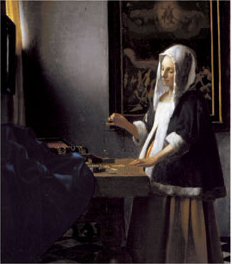
Woman Holding A Balance. Jan Vermeer, 1657
Vermeer’s subtle and sensuous representation of light—especially of the sparkling little pointilles one sees in his rendering of highlights—has been attributed to his use of the camera obscura. The image projected on the camera’s translucent screen helped him to solve problems of perspective and served as a guide to the distribution of light.
—from Varieties of Visual Experience, by Burke Feldman, pg. 144
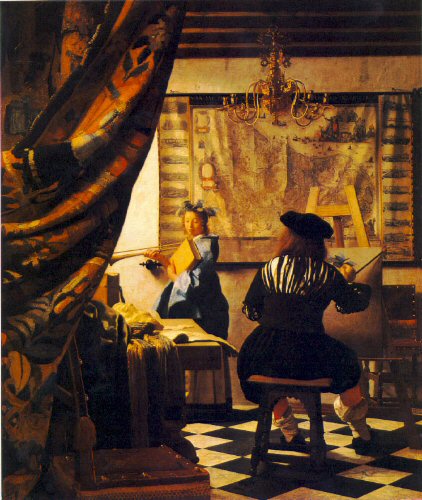
The Artist In His Studio. Jan Vermeer, 1665
Another painting that reveals profound insight is Jan Vermeer’s The Artist In His Studio. Vermeer also painted himself at work, but here there is no royal portrait in progress. Our eyes move immediately past the heavy curtain pulled up to our left to the strong black and white contrast on the back of Vermeer’s shirt. We find ourselves looking with him at his painting on the easel and beyond that to the model. The model (perhaps his wife) is posing as an allegorical figure who may represent fame. She is only mildly interesting; she seems like a prop and acts as a neutral pivotal point. Taken all together, however, the scene is fascinating. The painting is a complete self-portrait, although we cannot see Vermeer’s face. He is showing us himself in his studio. But much more important than the physical circumstances is the way in which they are presented. His way. Although it looks as though we came upon this situation by chance, it is not so. Every relationship in this painting was carefully selected by Vermeer. As in the work of Velazquez, light and placement play very important roles. For Vermeer, light was a major element defining exactly the character of each thing he observed. The whole image is revealed by light as if created by light.
—from Man Creates Art Creates Man, by Duane Preble, pg. 34
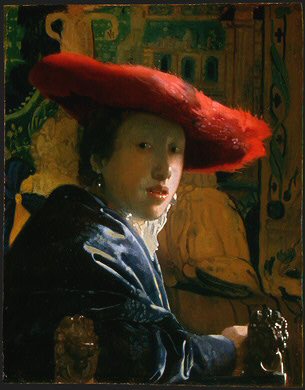
Girl With A Red Hat. Jan Vermeer, 1660
Jan Vermeer, a Dutch seventeenth-century painter, had a great love for the way light reveals surfaces. Recent research shows that he used a table-model camera obscura in order to see this quality more accurately.
Girl With A Red Hat is one of the painter’s early works. It was painted on a small wooden panel about the same size as the frosted glass on which the image would appear in the camera obscura. Vermeer evidently taught himself to see with photographic accuracy by copying images from the ground glass. In Girl With A Red Hat the focus has a narrow range. Only part of the girl’s collar and the left edge of her cheek are in focus. Everything in front of and behind that narrow band becomes increasingly blurred. The carved lion’s head on the arm of the chair in the foreground looks like shimmering light, just as it would appear in an out-of-focus photograph.
For Vermeer, the camera obscura was a point of departure, not a crutch. With it he was able to develop his perceptive powers and to give form to his excitement over optical reality as revealed by light. He did not stop at the imitation of surfaces. His own deep sense of design was behind each brush stroke. The personal sense of order that he gave to the composition of his subjects contributes to the lasting strength of his paintings.
—from Man Creates Art Creates Man, by Duane Preble, pg. 152
Ideally, each person viewing a work of art will determine his own idea of its quality. This is difficult to achieve because each of us brings preconceptions to everything we see. We have heard that Leonardo da Vinci’s painting called Mona Lisa is a great work of art. If this is foremost in our minds when we see the Mona Lisa, our own evaluation of quality becomes limited. But, can true quality be determined in this way?
Quality is relative. Concepts of what is valuable change from person to person, from age to age, and from culture to culture. Vermeer received some recognition in his own time. But he was largely forgotten in the eighteenth century and rediscovered in the nineteenth century. In the twentieth century Vermeer has received international acclaim.
If a work of art contributes to your experience, it has quality for you. Works of art that are considered great are those that have contributed to the experience of many people over a long period of time. Art’s quality cannot be judged on the basis of how well it imitates the appearance of the world around us. Art is selection and interpretation, not imitation.
—from Man Creates Art Creates Man, by Duane Preble, pg. 106
* * * * * *
The web site of the National Gallery of Art has an excellent in-depth study of Vermeer’s Woman Holding A Balance.
There are also many other websites with reproductions of Vermeer’s work and historical and biographical information. Just Google “Jan Vermeer”.




